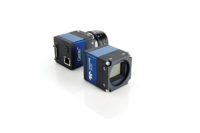GigE Vision® is a global camera interface standard developed using the Gigabit Ethernet communication protocol. The standard continues to be regarded as a major advancement in the field of high-performance industrial cameras, and dozens of leading companies offer hundreds of GigE Vision-compliant products. This article will examine the success of the GigE Vision standard and look ahead to version 3.0 and its enhancements.
Introduced in 2006, GigE Vision provides a framework for transmitting high-speed digital images, video, and related control data over Ethernet networks for fast image transfer via low-cost, standard cables up to 100 meters long. The Ethernet protocol’s native support for fiber optics means that GigE Vision applications operate over a range exceeding 500 kilometers, and even operate wirelessly. Using GigE Vision to implement the streaming engine of the camera is inexpensive and doesn’t require a frame grabber, so costs can remain low. All-in-all, if the camera needs to be a long distance away from the computer – more than 10 to 15 meters – GigE Vision is a good choice.
GigE Vision has been widely adopted in various machine vision applications, including manufacturing, robotics, traffic surveillance, medical imaging, and more. By utilizing Gigabit Ethernet technology, the GigE Vision standard enables the transmission of high-quality images and video over long distances with low latency. The current GigE Vision standard is robust, proven, and meets the needs of about 98% of customers today, most of which use 1 GigE cameras. Although a gradual shift to 2.5 and 5.0 GigE cameras is anticipated, there are very few current applications that require speeds over 10 GigE.
Today’s GigE drivers – when well-implemented – deliver an extremely robust and reliable solution for the vast majority of applications. However, the quality of software implementation to ensure the standard is robust varies across different vendors. Not all implementations are the same, so it’s important to work with a vendor who has proven implementations of GigE Vision and can demonstrate no incomplete or skipped images. This is an absolute requirement when you are working with medical imaging applications or, for example, a multi-camera tracking system in a sports arena.
Next, we’ll discuss the upcoming enhancements planned for GigE Vision 3.0, in the context that this version is designed for applications that require speeds of over 10 GigE.

Introducing RoCEv2, the Latest Enhancement to GigE Vision
The latest enhancement to the GigE Vision standard is RDMA over Converged Ethernet version 2 (RoCEv2) – an internet layer protocol that allows remote direct memory access over an Ethernet network. Remote Direct Memory Access (RDMA) is a data transfer mechanism that allows data to be transferred between the camera sensor to the memory of a computer without involving the CPUs.
RoCEv2 is planned to be released later in 2024 as part of GigE Vision 3.0. RoCEv2 shines in very high-speed applications with cameras over 10 GigE. Examples of these types of applications include high-performance computing and big data analytics, which are typically where less than 1-2% of all cameras are used today.
Who Benefits?
This is particularly beneficial in applications that require real-time high-quality image and video transmission. However, the integration of RoCEv2 into the GigE Vision standard requires careful consideration of various factors, including compatibility, cost, and the specific requirements of different applications. Manufacturing, robotics, medical imaging, and emerging applications in green energy and the environment may all benefit from this latest update.
While GigE Vision was introduced to standardize communication between applications and machine vision devices over Ethernet, suppliers of those same machine vision components, OEMs, and end-user system developers quickly recognized its considerable advantages – including enhanced flexibility, cost-effectiveness, and improved performance. In time, the specification has evolved to accommodate the widening requirements of machine vision systems but also tangential applications in life sciences imaging and augmented and virtual reality (AR/VR) scenarios, to name a few. With this latest release, GigE Vision will be able to accommodate future higher throughput cameras at a much lower CPU cost.
Put simply, imagine your computer networks as a vast highway system, and Ethernet as the main highway where data travels. This latest update is like increasing the speed limit on that highway. However, to take the analogy further, until the cars (cameras) operate at that speed, the speed limit increase is not a major consideration for most users.
The GigE Vision standard enhances the way computers talk to each other using a network interface card (NIC). The introduction of RoCEv2 allows for super-fast data streaming or a high-speed lane for critical data. Users of this standard will notice better performance and more efficient communication, especially with high-speed applications using 10 GigE cameras. RoCEv2 doesn’t replace anything; it’s just an extra feature, like adding a turbo boost to your car.
Key Benefits of RoCEv2 in GigE Vision:
RoCEv2 brings unparalleled speed, minimal latency, and an overall boost to system performance. Some of the key benefits include:
Low CPU Utilization:
The efficiency of RoCEv2-capable NICs is notable in their ability to offload data transfer tasks from the CPU. This reduction in CPU involvement in the data transfer process ensures that system resources are freed up, allowing them to be utilized for other tasks such as image processing. Consequently, this leads to enhanced overall performance.
Scalable Throughput:
RoCEv2 NICs offer a range of physical links, spanning from 10Gbps to 400Gbps. This broad spectrum of speed options significantly amplifies GigE Vision's adaptability to varied network demands, ensuring scalability across a diverse array of applications.
Enhanced Reliability at High Throughput:
RoCEv2 has enhanced the reliability of GigE Vision through its robust error-handling capabilities, for example at 25 GigE or higher. By delegating error detection and recovery tasks to dedicated hardware, the protocol ensures a smoother and more consistent data transfer with fewer glitches and hiccups during data transmission. This proactive approach minimizes disruptions in critical applications, enhancing stability and reducing the risk of interruptions.
Low Latency:
RoCEv2 introduces low latency, a critical factor in machine vision applications where real-time data processing is essential. This reduction in latency enhances the responsiveness of the imaging system, making it ideal for applications such as robotics and automation where split-second decisions are crucial.
Compatibility and Interoperability:
An essential prerequisite for the development of the upcoming major release is to preserve compatibility with existing devices. The current GigE Vision control protocol will be retained as the mechanism for device discovery and configuration. This strategic choice ensures a seamless transition for industries and applications currently reliant on GigE Vision, minimizing the need to significantly overhaul existing software while providing users with the flexibility to leverage new streaming capabilities.
In summary, the incorporation of RoCEv2 into the GigE Vision standard – with its emphasis on minimal CPU usage, high data transfer rates, reduced latency, and compatibility – anticipates the requirements of high-speed applications with camera speeds over 10 GigE. At the same time, companies that are successfully using the current GigE Vision-compliant products today do not have to make any changes. To reiterate, RoCEv2 doesn’t replace, it enhances, and the existing functionality remains intact. As the capabilities and speed of imaging systems continue to expand, the integration of RoCEv2 with GigE Vision offers new options for the most demanding and highest-speed applications.


